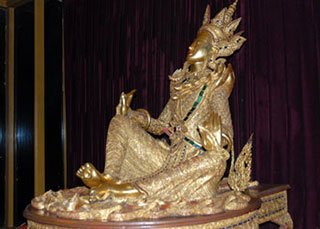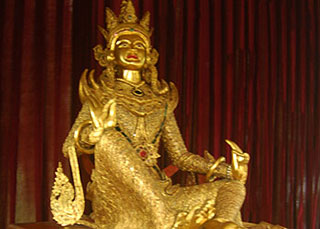The Lokanat is for the Myanmar people a symbol of peace and prosperity and figures prominently in our art and culture. The role of the Lokanat as peacemaker is based on a fascinating legend which has come down through the generations.
Once upon a time. the Guardian Spirit of the universe. known as the Loka Byuha Nat or Lokanat was making the rounds of his domain to see that all was well. when he came upon the Kethayaza Chinthemin. King Lion. and the Flying Elephant locked in mortal combat. The fight had broken out over attempts to grab the lacy tender clouds which were the favourite sustenance for both. Now the lion was pressing his foot down on the elephant with all his might and sucking at the trunk. The flying elephant was also doing his utmost to pierce the lion with his tusks.


The Lokanat foresaw that if the tempo of the combat should intensify and become more violent. then the entire earth itself would be set ablaze and left a heap of ashes. So. to put an end to their enmity and instead plant and nurture love and amity between them. he started to play a rhythmic beat on his small musical timing cymbals. sing in his melodious voice and dance in tune to it.
The two combatants hearing the soothing voice in song and seeing the graceful dance. calmed down and stopped their fight. Thus. their resentment and rancour diminished and the fire of their wrath was extinguished.
The term Lokanat in popular usage today is also said to be derived from the name of a deity named Lokanahta. which is the combined form of two Pali root words. Loka. meaning people in general and Nahta. meaning refuge or haven. So the Lokanat was originally the title of the deity who is believed to keep eternal watch over the world. In derivation. it later came to denote a prince or a ruler whose benevolence and wisdom protected the people of the kingdom and bestowed good fortune. The Buddhist monk Shin Maharahtathara. a poet and writer of great renown in Myanmar literature referred to King Saw Bramhadatt as Lokanat in his epic poem about Buridhatt. the future Buddha.
The very concept of a deity as gentle peacemaker seemed to have captured the imagination of creative artists. old and new. Myanmar sculptors and painters have fantasized greatly in their portrayals of many celestial beings and deities. but the figure of the Lokanat is different and special. He is always portrayed in a sitting position on a pedestal with a lotus-shaped platform. His posture is singular. sitting with one knee raised and the other laid down flat in a curved position with his feet clutching the musical timer cymbals. The hands are raised in a dance choreography with the delicacy and grace and suppleness of a bird’s wing in flight; the face is a study of serenity. yet the upward tilt of the chin brings to it a touch of light and joy. It is no wonder that for us. the Lokanat figure has become synonymous with peace joy and artistry.
The Lokanat is the favourite subject of Myanmar’s sculpture and painting. In fact it would not be wrong to say that the Lokanat is the logo of the visual arts in Myanmar. Its graceful figure is also frequently seen adorning the Myanmar traditional saing-waing (traditional orchestra). for he is regarded the patron of the performing arts as well. As a matter of fact. the Lokanat stands for peace and harmony. happiness and joy and all that is good and right. The figure is often placed in a prayer chamber or throne room. A Lokanat figure has been placed in the foreground of the Thihathana Throne now on display at the National Museum.
The lotus leaf pedestal of the Lokanat represents a leaf struggling out of the grip of the murky depths of a pond to emerge fresh and green on the water’s surface. and the entwining vines are like wavelets lapping at the edges. For the Myanmar people. a lotus leaf signifies peace and purity. an escape from the frailty of mundane life into the sunlight of wisdom and truth. This is in complete harmony with the celestial figure which stands for peace and serenity.
It is said that Mahayana Buddhists pay homage to the Lokanat as a deity who watches over the universe. and some others believe that if one takes refuge in the Lokanat. one will be free of all dangers and will be rewarded with untold wealth and happiness.
One of the earliest portrayals of the Lokanat is part of the ancient murals on the walls of the Apeyatana Temple in Bagan. On the wall of the ambulatory corridor of this temple can be seen a portrait of Awalokitesvara also known as the Lokanahta or Lokanat. He is depicted sitting on a huge lotus blossom with his left leg curved and upright and his right laid down on a smaller lotus blossom. The right hand is placed on the knee with the fingers hanging downwards and the left is bent at the elbow and placed on the chest. but holding by the stalks. a boquet of lotus blossoms and buds. He wears a crown and is adorned with a beaded necklace as well as bangles and bracelets. The Awalokitesvara or the Lokanat is said by some to be a prominent Boddhisatt deity of Mahayana Buddhism.
The sitting position of the Lokanat. the Lelathana posture. can be found in some Buddha images of the Vesali Era of the Rakhine State. In the Bagan region. figures of the Bodhisatt carved and painted in this manner can be seen in the Pawdawmu. Paungku. Ananda and Apeyatana Pagodas as well as in some pagodas in Kanthit village. Yesagyo Township and Kanbe village in Tuntay township.
The Lokanat. though ancient in origin. still holds a fascination for the Myanmar people today. No artist of any talent. be he painter or sculptor. can resist an attempt to create the Lokanat as he. or she sees him.The artist of the Myanmar Perspective Lokanat is no exception. He has captured in gold. the litheness of the body and limbs. the sweetness of the face and the nobility of the brow. yet true to its attribute of benevolent ruler. the figure in the painting exudes an aura of authority. wisdom and compassion.
What is certain is that. for the Myanmar people. the Lokanat is a symbol of peace and the essence of our art and culture. His whole being is typically Myanmar. So. with the Lokanat’s blessings may peace reign in our land and our people flourish and prosper.
Kyi Kyi Hla

Comment (0)